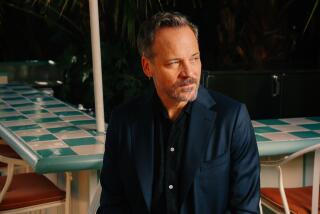Before ‘Howl,’ the hospital
- Share via
TO William Burroughs, it was “insufferable” -- a sign that The Man was reaching his tendrils deep into a poet’s psyche.
To some Beats and fellow travelers, Allen Ginsberg’s time in Columbia Presbyterian Hospital, where he was sent by a judge as a very young man, seemed like a scene from “One Flew Over the Cuckoo’s Nest”: establishment America grinding down a free spirit.
And to the poet’s best-known biographer, it was the revenge of Squaresville: The doctors, Barry Miles writes in his 1989 “Ginsberg: A Biography,” “thought their job was to make Allen conform and fit into a ‘Saturday Evening Post’ view of society, with a wife and an ordinary job.”
But to a local literary scholar and psychotherapist, who got unusual access to the poet’s psychiatric records, his seven months in the hospital’s psychiatric ward in 1949 and ’50 was not an assault on his individualism.
“My argument is that he was in a state of collapse and that he needed that hospitalization,” says Janet Hadda, a petite and energetic woman, in her Hancock Park home office. Now a retired UCLA professor of Jewish and Yiddish literature, she came to her conclusion after reading a wide range of personal and medical records, including some seen by only a handful of people.
Rather than squelching his creativity, this period of enforced rest and routine actually made the callow young man a great writer. “I think he was allowed to be crazy,” Hadda says. “So everything came out -- and he lived through it. Most people are terrified what will happen if they lose it. But it happened to him, and he survived. He didn’t have to be afraid because everything had already happened.”
In her article, “Ginsberg in Hospital,” to be published in the Freudian quarterly “American Imago,” Hadda describes this often overlooked period “as a seminal moment in the formation of Allen Ginsberg, poet and public figure, iconoclast and icon.”
In the literary world, 2006 was certainly Ginsberg’s year. There were several new books and many articles devoted to the genius of Ginsberg’s era-defining poem “Howl,” which just marked its 50th anniversary. This onetime rebel has been enshrined as an Esteemed Author and likened to Walt Whitman.
But in the late ‘40s, Ginsberg was a bright but confused Columbia student with unconventional friends. Some of them, such as Burroughs and Jack Kerouac, would go on to become celebrated bohemian writers. Others were dodgy small-time hoods. Ginsberg was also hearing voices of dead artists and poets, including that of William Blake, and hallucinating that the people around him were grotesque “wild animals.”
What followed, says Peter Hale, director of the New York-based Allen Ginsberg Trust, is a chunk of his life that’s typically overlooked and that the poet never discussed with him. “No one has really looked into that period very much,” says Bill Morgan, the poet’s former archivist and author of the new book “I Celebrate Myself: The Somewhat Private Life of Allen Ginsberg.” “Other people haven’t had access to that material.”
It was when the budding poet was tied to an incident of burgling that he was sent to Columbia Presbyterian, which the writer entered as part of a plea bargain. This didn’t exactly predispose Ginsberg’s crowd to look kindly on the move: The arrangement, as Miles said by phone from his London home, seemed to pit “the forces of Columbia University and the family against Ginsberg’s bohemian lifestyle.” That the hospital tried to “cure” the poet’s homosexuality -- standard practice in those days -- didn’t help.
But Hadda said his correspondence and medical records show a young man whose life with a schizophrenic mother and the resulting need to be prematurely responsible wore him down, pushing him into either a narcissistic or “borderline” state. (The poet, born in Newark in 1926, was the son of Louis and Naomi Ginsberg, his father a poet and high school teacher, his mother a communist who suffered from paranoia and schizophrenia.)
His sense of reality rose and fell during his hospitalization, and he went through a wide range of anxieties. Ginsberg was both troubled and excited by mental illness: He worried he’d end up like his mother, who’d been lobotomized, but was also energized by the madness of others. Hadda says he was able to come to terms with some of those contradictions there.
For one thing, he saw patients far more unhinged than he. “The people here see more visions in one day than I do in a year,” he wrote to Kerouac. “Allen did not successfully confront the boundary between unending madness and temporary collapse,” Hadda writes, “until his sojourn at the Psychiatric Institute.” That boundary ended up being quite strong: After this period, Ginsberg never had another mental breakdown.
Other details of this interlude were important for Ginsberg: He met fellow outlaw intellectual Carl Solomon, who introduced him to the work of Jean Genet and to whom “Howl” was dedicated, and picked up imagery he’d use later. “Howl,” after all, begins: “I saw the best minds of my generation destroyed by madness, starving hysterical naked....”
“Kaddish,” published in 1961, was about his mother’s mental illness, and was also likely informed by his time in Columbia Presbyterian, Hadda said. In general, she said, his time in the hospital allowed him to “be crazy in his writing” but lead a comparatively balanced life.
Later in life, he corresponded with mental patients who sought him out. “He could be in touch with it,” she says, “but he didn’t have to live it.” The experience, says Hale, “seems to have endeared Allen to insane people even more than he already was.”
Ginsberg, of course, isn’t the only poet or artist to be a bit cracked. Robert Lowell was only one of many mad poets of the midcentury period. Romanticism, which was dedicated to reaching the irrational, produced more than its share of great figures who were unmoored. Some of romanticism’s myths die hard.
“Somebody just asked me over the weekend,” Hadda recalls, “ ‘Don’t you think that if so-and-so had had psychiatric care, he would not have been as great an artist?’ This is an absolutely pervasive idea: that mental health somehow blunts creativity. I hear it all the time.”
That notion, she says, “can be personally destructive to people” who could benefit from therapy, “but feel that they will cease to be themselves. It’s a very old idea: that madness and creativity go together. Which they often do, but the opposite isn’t necessarily true. I know there are a lot of mad people who are not creative. Most of them, I think.”
Miles’ 588-page Ginsberg bio, which came out of both research and a quarter-century of friendship between the journalist and poet, makes only a few pages’ mention of Ginsberg’s psychiatric interlude. When told of Hadda’s thesis, he said: “I heard that from Allen’s father, who thought it was a very good thing, that it straightened Allen out a bit.”
Miles admits to mixed feelings about that period of the poet’s life. The fact that the medical establishment of the 1940s viewed homosexuality as an illness that could be treated disturbed him, as it disturbed many at the time. And the hospital used shock therapy (though not on Ginsberg, who was treated mostly with talk therapy).
“On the other hand, he was definitely drifting, becoming a bit sloppy and careless about his own life. Clearly he needed something to refocus his mind,” he says.
Some of Ginsberg’s friends took a harder line. “William,” Miles says of Burroughs, “was very disapproving of Allen going into the Columbia Presbyterian Hospital. He thought they were going to brainwash him and turn him into some kind of consumerist, crew-cutted American, and wrote him a number of letters about this.”
But after hearing Hadda’s thesis, Miles said he saw her point. “I would probably agree with it ultimately.” He doesn’t see this stretch as an unalloyed good. “But I think his time there was probably quite valuable.”
Miles also points out that the hospitalization falls in the period of Ginsberg’s life that shaped him most profoundly -- his student years into his 20s. “The later hanging out with Kerouac and traveling the world and taking drugs and stuff are not nearly as important as these early experiences.”
More to Read
Sign up for our Book Club newsletter
Get the latest news, events and more from the Los Angeles Times Book Club, and help us get L.A. reading and talking.
You may occasionally receive promotional content from the Los Angeles Times.










